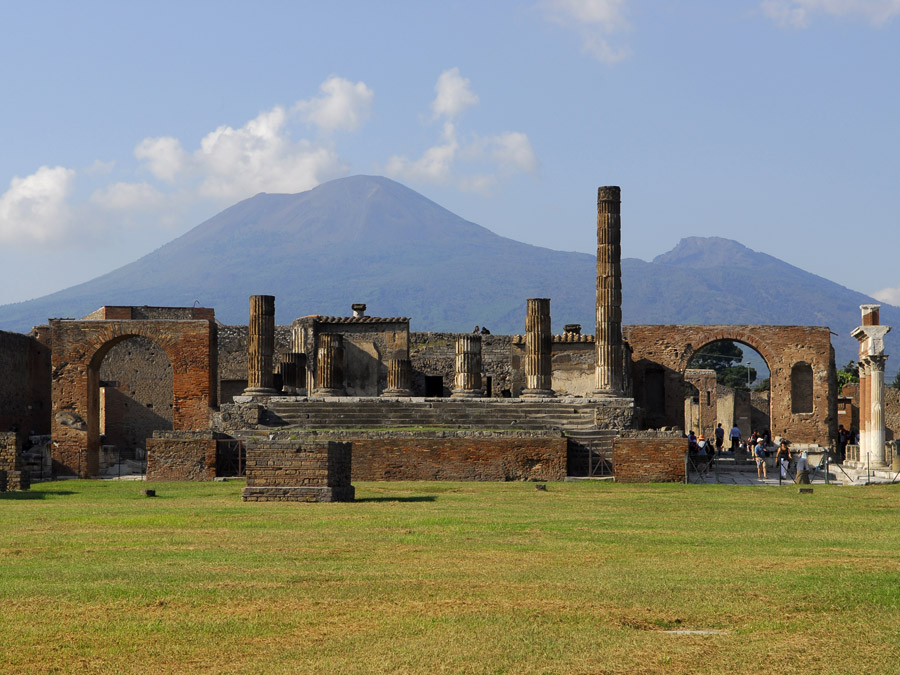Saving the ruined city
Preserving Pompeii for posterity

Almost two thousand years ago, the city of Pompeii was buried under a shroud of ash and lava ejected by nearby Vesuvius. The eruption in 79 AD essentially froze the ancient city, preserving it for centuries. Large-scale excavations did not begin until the 18th century. Bit by bit, the city began to reveal its secrets about life in ancient times.
As one of the largest self-contained sites surviving from antiquity, Pompeii is a treasure trove. Each new excavation yields new knowledge, and is greeted with huge interest by the public and research community. All too often however, a lot less interest has been shown in the sustainable preservation of this unique site.
Many of the finds, most notably Pompeii’s frescos, have been moved to museums, to protect them from the wind and weathering. But because of inadequate conservation measures, the exposed walls of the city with their lavish decorations are now visibly disintegrating.
Pompeii as a center of world-class research
The researchers participating in the Pompeii Sustainable Preservation Project intend to concentrate on one of Pompeii’s apartment buildings, known as an insula. From 2014, they will embark on an ambitious conservation program, taking in everything from elaborate murals to the smallest wall. “The first step will be drainage, followed by new types of protective structures. But that is just the start,” explains Professor Erwin Emmerling of TUM’s Chair of Restoration.
An important new approach is preventive restoration. “To date, this has not been undertaken on an adequate scale. We want to find out more about ongoing restoration,” continues Emmerling. The researchers will only use simple, traditional materials. In any case, large equipment like cranes would be of no use in the narrow streets of Pompeii. They will also have to make do without concrete because it was not used in those days. Instead, the restoration team will use lime and other traditional building materials.
Modern technology for ancient monuments
But the researchers will not be foregoing all high-tech aids. They will use nanotechnology to make the lime more fluid, thus stabilizing the frescos through backfilling. The experts intend to conserve the topmost layer of the paintings using lime and silicon compounds.
Researchers from various disciplines will be working alongside restoration experts and archeologists in the Pompeii Sustainable Preservation Project. The ancient city will be accurately surveyed both on the ground and through aerial photographs. Seismic measurements will provide information on how the monument will be impacted by future seismic activity, which will help to ensure that the conserved structures will later withstand these tremors. Construction and structural engineers will be supporting activities in this area.
Last but not least, suitable sites within Pompeii are to be re-landscaped, and the project as a whole will be a training site for conservationists from around the world.
The key partners in the Pompeii Sustainable Preservation Project are Technische Universität München (Chair of Restoration, Art Technology and Science of Conservation), Fraunhofer-Gesellschaft (Fraunhofer Institute for Building Physics), and the International Center for the Study of the Preservation and Restoration of Cultural Property (ICCROM), which is attached to UNESCO. These institutions will be assisted by the Soprintendenza Speciale per i Beni Archeologici di Napoli e Pompei and the Istituto Superiore per la Conservazione ed il Restauro, which is a body of the Italian Ministry of Cultural Heritage. The University of Oxford’s School of Geography and the Environment, the Department of Ancient History at Ludwig Maximilian University in Munich, the German Archeological Institute (DAI) in Rome, the University of Pisa and the Istituto per i Beni Archeologici e Monumentali of the Consiglio Nazionale delle Ricerche (CNR) are supporting the project as research partners.
More Information:
Press pictures in high resolution.
Contact:
Prof. Erwin Emmerling
Technische Universität München
Lehrstuhl für Restaurierung, Kunsttechnologie und Konservierungswissenschaft
T: +49.89.21124.568
E: emmerling@tum.de
W: http://www.rkk.ar.tum.de/